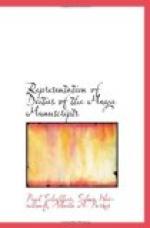B. The God With the Large Nose and Lolling Tongue.
[Illustration: Figs. 7-10]
The deity, represented most frequently in all the manuscripts, is a figure with a long, proboscis-like, pendent nose and a tongue (or teeth, fangs) hanging out in front and at the sides of the mouth, also with a characteristic head ornament resembling a knotted bow and with a peculiar rim to the eye. Fig. 7 is the hieroglyph of this deity. In Codex Tro.-Cortesianus it usually has the form of Fig. 8.
God B is evidently one of the most important of the Maya pantheon. He must be a universal deity, to whom the most varied elements, natural phenomena and activities are subject. He is represented with different attributes and symbols of power, with torches in his hands as symbols of fire, sitting in the water and on the water, standing in the rain, riding in a canoe, enthroned on the clouds of heaven and on the cross-shaped tree of the four points of the compass, which, on account of its likeness to the Christian emblem, has many times been the subject of fantastic hypotheses. We see the god again on the Cab-sign, the symbol of the earth, with weapons, axe and spears, in his hands, planting kernels of maize, on a journey (Dr. 65b) staff in hand and a bundle on his back, and fettered (Dr. 37a) with arms bound behind his back. His entire myth seems to be recorded in the manuscripts. The great abundance of symbolism renders difficult the characterization of the deity, and it is well-nigh impossible to discover that a single mythologic idea underlies the whole. God B is quite often connected with the serpent, without exhibiting affinity with the Chicchan-god H (see p. 28). In Dr. 33b, 34b and 35b, the serpent is in the act of devouring him, or he is rising up out of the serpent’s jaws, as is plainly indicated also by the hieroglyphs, for they contain the group given in Fig. 10, which is composed of the rattle of the rattlesnake and the opened hand as a symbol of seizing and absorption. God B himself is pictured with the body of a serpent in Dr. 35b and 36a (compare No. 2 of the Mythological Animals). He likewise occurs sitting on the serpent and in Dr. 66a he is twice (1st and 3d figures) pictured with a snake in his hand.
God B sits on the moan head in Dr. 38c, on a head with the Cauac-sign in Dr. 39c, 66c, and on the dog in Dr. 29a. All these pictures are meant to typify his abode in the air, above rain, storm and death-bringing clouds, from which the lightning falls. The object with the cross-bones of the death-god, on which he sits in Dr. 66c, can perhaps be explained in the same manner. As the fish belongs to god B in a symbolic sense, so the god is represented fishing in Dr. 44 (1). His face with the large nose and the tongue (or fangs) hanging out on the side in Dr. 44 (1)a (1st figure) is supposed to be a mask which the priest, representing the god, assumes during the religious ceremony.




